Culture
'India's Contribution To World Thought And Culture': Return Of A Classic
Aravindan Neelakandan
Nov 04, 2022, 08:09 PM | Updated 08:11 PM IST
Save & read from anywhere!
Bookmark stories for easy access on any device or the Swarajya app.
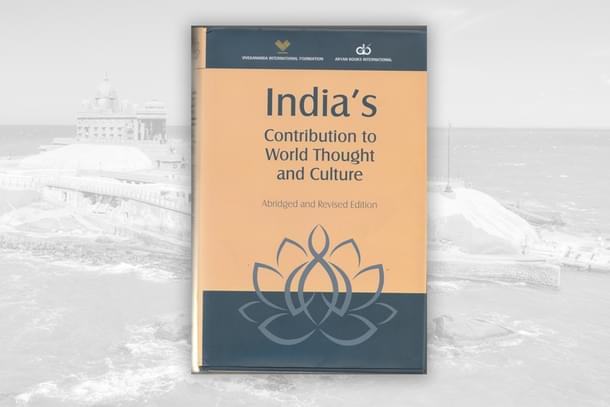
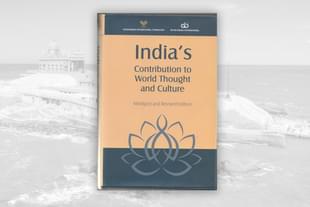
India's Contribution to World Thought and Culture (Hard Bound), Abridged and Revised Edition (2022). Vivekananda International Foundation (VIF) and Aryan Books International (ABI). Pages 484. Price: Rs 995
Eknath Ranade was the principal force behind the mid-sea rock memorial for Swami Vivekananda in Kanyakumari.
When he was working for the rock memorial, fighting all odds, a vision started taking shape: this should not be just a memorial for Swami Vivekananda but a nation-building movement, and that alone could be a fitting memorial for Swami Vivekananda.
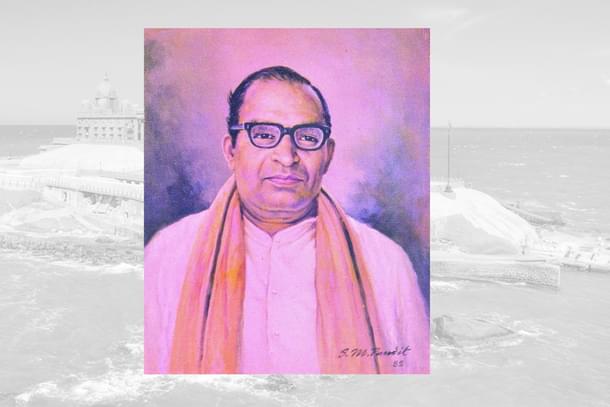
Vivekananda Kendra is the living movement of a memorial he created.
This is a very unique organisation in the sense that it is an order of non-sanyassin workers dedicatedly working in almost all spheres of national life.
In culture, spirituality, rural development, tribal development, Yoga, sustainable development and journalism, Vivekananda Kendra has made impressive contributions.
In 1970, even as the Vivekananda Rock Memorial was taking shape and hectic work was going on to complete it, Eknath Ranade with superhuman energy resolved to supplement the work with another equally arduous work - a Swami Vivekanand Commemoration Volume.
This Volume brought out in a rigorous, scholarly way the contribution of India to the world thought and culture.
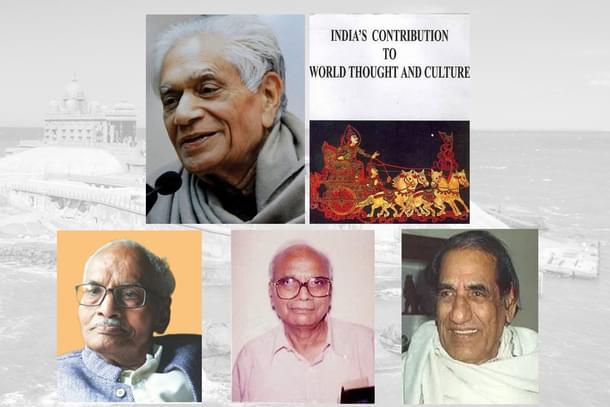
The editor-in-chief was Prof. Lokesh Chandra. The contributors were historians, Prof. Devendra Swarup and Sitaram Goel and eminent archaeologist Dr. S.P. Gupta.
At a size of a standard Encyclopaedia Britannica and with 700 pages, it was priced RS 150/- . The book is a collector's item and a must read for every student of Indian culture and history.
Now, the Vivekananda International Foundation (VIF) and Aryan Books International (ABI) have brought out an abridged and revised edition of the book.
Distilled from seventy scholarly papers (some of them dated) this abridged edition has twenty seven papers. Each is a treasure trove of knowledge.
The book carries the original foreword written by that doyen of historians - R.C.Majumdar. It sets the context to the book.
While historians of colonial and even post-colonial period have tended to portray Buddhism as a missionary religion, Hinduism has been shown as a non-missionary religion.
Hindu Dharma did not and cannot proselytise but it definitely spread in an organic way, interacting with other spiritual and cultural traditions, enriching and getting enriched by these interactions.
So Hindu Dharma is in its own way a non-proselytising missionary religion.
In his foreword, Majumdar had pointed to the destruction of Hindu temples in Central Asia by Christian zealots. Right in the foreword he brings out details which are seldom talked in our textbooks regarding the spread of ancient Hindu culture:
The story of the spread of Buddhism since the time of Asoka, about the middle of the third century BC, is well known. Far less known is the fact that Hinduism i.e. the Puranic form of Brahmanical religion, was already spread in parts of Asia, and abundant traces of Hinduism and other aspects of Indian culture associated with it still remain in various regions of the continent. It would perhaps be news to many that there was an Indian colony in the region of the Upper Euphrates river, to the west of Lake Van, as early as the second century BC. and the temples of Hindu gods, like Krishna, erected there were destroyed by the Christian monk St. Gregory early in the fourth century AD, after defeating Indians who stoutly resisted the iconoclastic fury of Christians.R.C.Majumdar, Foreword, 14-4-1970
After 52 years, these historical facts still remain 'news to many'. Such is the stranglehold of the colonial narrative.
The new abridged edition carries a foreword by Arvind Gupta and an introduction by the renowned archaeologist Dilip Chakrabarti.
The introduction itself is a veritable scholarly treat and quite a comprehensive guide to navigate through the vast sea of knowledge that the papers subsequently offer the reader.
It is one of the best holistic summaries of India's cultural heritage that brings out both its para and apara knowledge heritages while maintaining their organic integrity.
The papers have been selected with care and relevance. While in the original the relevant picture plates were mostly given separately, here they are provided in-text which makes the reader relate in a better way.
Starting with India's contribution to the history of Science and ending with Swami Ranganathananda's paper on Swami Vivekananda as India's emissary to the West, the selection of papers remains relevant to the spirit of the makers of the original volume.
The students of Indian civilisation as well as scholars will learn a lot from this present volume that can challenge the preconceived concepts which have become part of the indoctrination of colonial/colonised historians.
For example, it is often said that Buddhism was anti-Vedic. Many 'scholars', politicians and writers to this day aggressively promote the unsubstantiated claim that later 'Brahminical' religion appropriated Buddhism making Buddha an Avatar of Vishnu.
This is often axiomatically accepted.
In this book there are two papers. One by an Indologist from erstwhile USSR - B.A. Litvinsky - 'India and Soviet Central Asia'. Another by Indologist and art historian P. Banerjee : Hindu Deities in Central Asia.
In both papers a specific inscription is discussed among others.
Discovered in 1956 by Russian scholar A.N , Berushtam in Tajikistan , this Kharosthi inscription identified by linguist J.Harmatta as the oldest Kharosthi inscription in inner Asia reads 'Narayana Jaya Ho'. This is considered Buddhist! Because? Litvinsky explains:
Narayana, the Buddha is encountered in the Khotanese-Saka documents from Eastern Turkistan, and “Narayana, the deva” occurs in the Buddhist Soghdian documents.p.165
In the subsequent paper on the same subject, when dealing with the same inscription, P. Banerjee points out even more interesting facts:
It may be noted here that Narayana the Buddha is mentioned in the Khotanesa-Saka documents in Eastern Turkistan and Narayana, the deva occurs in the Buddhist - Soghdian documents.- On a Tun-huang painting representing a thousand- handed, thousand-eyed Avalokitesvara, occurs an attendant figure, Narayana on Garuda. In all these contexts ’Narayana’ seems to occur in its Buddhist association, though it is quite possible that his Hindu features were not completely unknown in Central Asia.p.179
What is to be seen here is that both the authors point to the fact that Narayana is the name associated with Buddha as his name travelled West from India.
At the same time coinciding with this westward advancement of Buddha, was the Greco-Bactrian or Indo-Greek king Agathocles of Bactria who circa 150 BCE issued the now famous Sri Krishna coins.
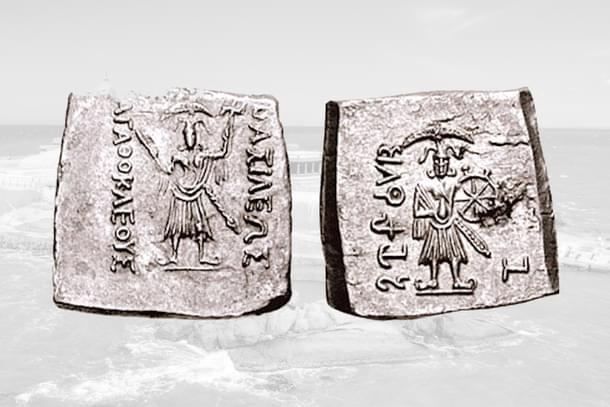
The geographical and chronological affinities strongly suggest that Buddhist tradition also used the popularity of Krishna-Narayana tradition in these regions for its own spread.
So it may not be that Vedic Dharma appropriated Buddha, but Buddha Dharma 'appropriated' (and that is not the right term) the Krishna-Narayana tradition.
The book does not spell it out but it provides a holistic picture that removes the implanted prejudices.
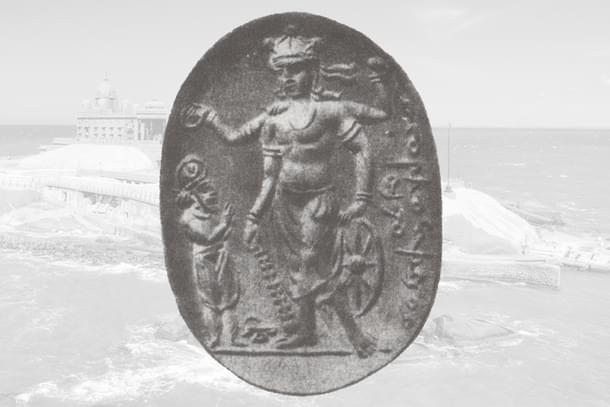
Recently in Tamil Nadu certain politicians made a statement that Vaishnavism and Saivism were separate religions and their unity was because of the British.
However if a student of politics goes through this book, he or she would find that it the composite Divine form uniting Vishnu and Siva - popularly known in southern India as Sankara Narayana- existed as early as fifth century even in Central Asian region.
Such a comprehensive scholarly volumes should now become the source material for writing our textbooks. That is another important possible benefit we can derive from such books.
In the original edition, the paper by historian K.S. Ramachandran, Ancient Indian Maritime Venture, highlighted the Chola contribution to the spread of Hindu culture and traditions to South East Asia:
But by far the most important evidence of naval expedition and conquest pertains to the Imperial Cholas. In A.D. 983 Raja Raja I led a successful naval expedition against the Ceylon ruler Mahinda V. Again, his illustrious son Rajendra invaded this island during the reign of the same ruler. Raja Raja also led a naval expedition and conquered the old islands of the sea numbering 12000, perhaps the Maldives. ... The most outstanding achievement of the Cholas was the conquest of Kadaram (Kedah in the Malay Peninsula) by Rajendra.p.80 [unabridged original edition]
The paper is not included in the abridged edition. Because here, the paper by S.R. Rao on Shipping in Ancient India has been included which is also a very elaborate and detailed paper. It also contains very important insights in to Harappan marine ventures. Even after more than half a century the paper scintillates with fresh insights.
This reviewer has a request. In his introduction, Dr. Chakrabarti makes an important point about this volume:
Each of its articles covers, so as to speak, the tip of an iceberg and brings to light the importance of further research on each of these research areas from the Indian side.
This is very much true. For example in the unabridged volume there is a paper 'The Aryans: A Reappraisal of the Problem' by the renowned archaeologist B.K.Thapar of ASI.
At that time it was almost universally concluded that the painted grey ware was the archaeological correlate of 'Aryan' migratory movements. In the conclusion of the paper Thapar raised some doubts:
To which wave of the movement of Indo-Aryans does the Painted Grey Ware belong, if at all it belongs to one, still remains to be established. ... Lest the conclusions be bedevilled by extrapolations and surmises, it must be re-affirmed that the available objective evidence for the movement of Aryans into India is still inconclusive. In the present state of our knowledge or, for that matter of our ignorance, which is not as despairing as it was two decades ago, calls for a sustained work on the problem, including the ancestry of the Painted Grey Ware if it was at all there outside India.p.161 (emphasis in the original)
The reader should remember again that this was written in 1970 - half a century and two years ago. Now it is as universally accepted as before that the association of painted grey ware (PGW) pottery with 'Aryan movement from steppe' was hasty and wrong.
For example Harappan archaeologists Jean-François Jarrige and Usman Hassan opine that the 'grey ware could very well be explained within its local context.'
Here it should be pointed out again that Dr. Chakrabarti who wrote the introduction to the present volume had as early as 1968 pointed out to the possibility of the obsessive association of PGW with Aryan movement leading archaeologists to neglect the context of localised cultural dynamics.
The original volume thus contains many invaluable gems of insights.
That is the reason why one expects from Vivekananda Kendra, Vivekananda International Foundation and Aryan Books International an annotated, enlarged and updated version of the original volume - perhaps even a couple of volumes.
The publication of this attractive, timely and inspiring abridged edition is not a culmination of the great work that the great visionary Sri Eknath Ramakrishna Ranade started but a wider and more challenging beginning.
This abridged edition is a very important reading material for students and scholars alike. It is an essential book for decolonising our minds.
The selection of the papers from the original has been done with diligence and having the modern reader in mind. The reproduction of the images are done professionally and are pleasing to the eyes of the reader. The book will definitely ignite in the minds of the readers an urge to own the original monumental work.
The current generation is indebted to both VIF and ABI for bringing out this classic in an adorable and affordable form.
You can order the book online here.
Aravindan is a contributing editor at Swarajya.





